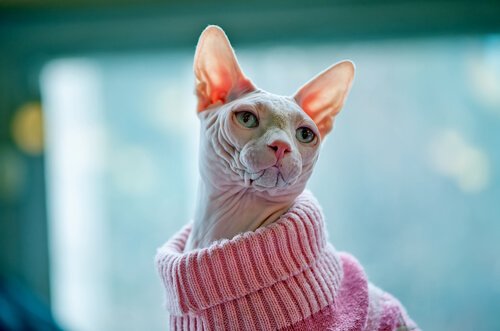The Best Clothes for Your Pet


Written and verified by the lawyer Francisco María García
Pet clothes often look so lovely that we are tempted to buy them for our furry friends. However, before dressing them up, it is worth knowing the advantages and disadvantages of pet clothes.
The advantages of pet clothes: Protecting them from cold weather
The arrival of winter can bring more serious problems than you might expect. It is essential to remember that the cold can create respiratory issues and aggravate certain joint diseases.
Some dog breeds have adapted to the cold over time because they originated in countries with extreme climates. This is the case with Nordic breeds, whose bodies have a double layer of fur and a thick layer of fat.
Follow the breed
If your dog is a Siberian Husky, Shar-Pei, Samoyed, Alaskan Malamute or a Chow-Chow, it is not necessary dress him in clothes to protect him. His own body is already prepared to withstand really low temperatures and clothes can bother him.

Smaller dogs with little fur are often very vulnerable to cold climates. Their bodies are more fragile and are not prepared to survive in the outdoors, so they can easily get sick. The breeds that need more care in cold temperatures are: Yorkshire Terriers, Pinschers, French bulldogs, Boston Terriers, Pugs, Chihuahuas, Miniature Bull Terriers and Chinese Crested dogs.
As far as cats as concerned, their bodies are naturally more vulnerable to the cold than dogs. Thus, exposing your little feline to unfavorable weather conditions can make him severely ill.
Preventing injuries and blows
Another advantage of dressing your pet is that it provides him with protection, prevents chafing, bumps, wounds or scratches. If your pet is in a more ‘unruly’ period, clothing can keep him from getting hurt; and there are also special clothes that provide additional protection against bacteria, parasites and environmental allergens.
The disadvantages of dressing your pet in clothes
One of the biggest disadvantages of clothes for your pets is that they can produce allergic reactions in your pets. There are many breeds of dogs and cats that naturally have very delicate skin. For them, just the rubbing of fabric or the stitching on clothes or toys could cause them a lot of discomfort, allergies and skin inflammation.

Another drawback is that your pet’s clothes will require a more thorough cleaning to avoid the proliferation of microorganisms and bacteria in the home. Cleaning should also remove stains and odor.
We can also say that the current high activity of the garment industry for pets is a warning sign of the excessive humanization of pets. We must remember that having a companion animal also means respecting its natural characteristics.
Tips for choosing clothes for your pet
Before exposing your pet to contact with any clothes, it is very important to ensure the quality of the fabric and the sewing. Dressing our best friend up is supplementary; his health, comfort and well-being must be considered above all else.
Here are some tips to consciously choose clothes for your pet
- Find out if your pet is allergic to anything.
If your pet has never had an allergy test, it is important to consult with your veterinarian about this, especially if you have observed changes in his eating routine, in his behavior or on his body.
After finding out whether your dog is allergic or not, it will be possible to choose clothes that don’t make him uncomfortable
- Avoid garments with small trinkets.
Cats and dogs are curious by nature. They love discovering new and eye-catching objects, and they almost always they do so by licking them, chewing them or just playing with them. The problem occurs when there are objects on the clothes that can get stuck in their throats; this brings with it the risk of suffocation. Because of this, we should avoid giving them clothes with feathers, bells, buttons or the like.
Measurements
- Find out your pet’s measurements.
We can’t always be guided by the sizes given on the on pet clothes’ labels. To ensure that you purchase the right size, you must take your pet’s measurements. His height, the length of his body (from his neck to where his tail begins), the diameter of his neck and his abdomen.
- Observe your pet’s reaction.
Our preferences can sometimes interfere with our pet’s well-being. So, it doesn’t matter how beautiful a garment might look on your pet if your buddy doesn’t enjoy wearing it. For this reason, before imposing a new habit on your pet, it is essential to observe its reactions and emotions.
Pet clothes often look so lovely that we are tempted to buy them for our furry friends. However, before dressing them up, it is worth knowing the advantages and disadvantages of pet clothes.
The advantages of pet clothes: Protecting them from cold weather
The arrival of winter can bring more serious problems than you might expect. It is essential to remember that the cold can create respiratory issues and aggravate certain joint diseases.
Some dog breeds have adapted to the cold over time because they originated in countries with extreme climates. This is the case with Nordic breeds, whose bodies have a double layer of fur and a thick layer of fat.
Follow the breed
If your dog is a Siberian Husky, Shar-Pei, Samoyed, Alaskan Malamute or a Chow-Chow, it is not necessary dress him in clothes to protect him. His own body is already prepared to withstand really low temperatures and clothes can bother him.

Smaller dogs with little fur are often very vulnerable to cold climates. Their bodies are more fragile and are not prepared to survive in the outdoors, so they can easily get sick. The breeds that need more care in cold temperatures are: Yorkshire Terriers, Pinschers, French bulldogs, Boston Terriers, Pugs, Chihuahuas, Miniature Bull Terriers and Chinese Crested dogs.
As far as cats as concerned, their bodies are naturally more vulnerable to the cold than dogs. Thus, exposing your little feline to unfavorable weather conditions can make him severely ill.
Preventing injuries and blows
Another advantage of dressing your pet is that it provides him with protection, prevents chafing, bumps, wounds or scratches. If your pet is in a more ‘unruly’ period, clothing can keep him from getting hurt; and there are also special clothes that provide additional protection against bacteria, parasites and environmental allergens.
The disadvantages of dressing your pet in clothes
One of the biggest disadvantages of clothes for your pets is that they can produce allergic reactions in your pets. There are many breeds of dogs and cats that naturally have very delicate skin. For them, just the rubbing of fabric or the stitching on clothes or toys could cause them a lot of discomfort, allergies and skin inflammation.

Another drawback is that your pet’s clothes will require a more thorough cleaning to avoid the proliferation of microorganisms and bacteria in the home. Cleaning should also remove stains and odor.
We can also say that the current high activity of the garment industry for pets is a warning sign of the excessive humanization of pets. We must remember that having a companion animal also means respecting its natural characteristics.
Tips for choosing clothes for your pet
Before exposing your pet to contact with any clothes, it is very important to ensure the quality of the fabric and the sewing. Dressing our best friend up is supplementary; his health, comfort and well-being must be considered above all else.
Here are some tips to consciously choose clothes for your pet
- Find out if your pet is allergic to anything.
If your pet has never had an allergy test, it is important to consult with your veterinarian about this, especially if you have observed changes in his eating routine, in his behavior or on his body.
After finding out whether your dog is allergic or not, it will be possible to choose clothes that don’t make him uncomfortable
- Avoid garments with small trinkets.
Cats and dogs are curious by nature. They love discovering new and eye-catching objects, and they almost always they do so by licking them, chewing them or just playing with them. The problem occurs when there are objects on the clothes that can get stuck in their throats; this brings with it the risk of suffocation. Because of this, we should avoid giving them clothes with feathers, bells, buttons or the like.
Measurements
- Find out your pet’s measurements.
We can’t always be guided by the sizes given on the on pet clothes’ labels. To ensure that you purchase the right size, you must take your pet’s measurements. His height, the length of his body (from his neck to where his tail begins), the diameter of his neck and his abdomen.
- Observe your pet’s reaction.
Our preferences can sometimes interfere with our pet’s well-being. So, it doesn’t matter how beautiful a garment might look on your pet if your buddy doesn’t enjoy wearing it. For this reason, before imposing a new habit on your pet, it is essential to observe its reactions and emotions.
This text is provided for informational purposes only and does not replace consultation with a professional. If in doubt, consult your specialist.








